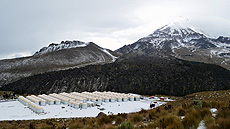Scientists complete array on Mexican volcano
 |
| An international team of astrophysicists has completed an advanced detector to map the most energetic phenomena in the universe. Photo courtesy of HAWC |
On Thursday, atop Volcán Sierra Negra, on a flat ledge near the highest point in Mexico, technicians filled the last of a collection of 300 cylindrical vats containing millions of gallons of ultrapure water.
Together, the vats serve as the High-Altitude Water Cherenkov (HAWC) Gamma-Ray Observatory, a vast particle detector covering an area larger than 5 acres. Scientists are using it to catch signs of some of the highest-energy astroparticles to reach the Earth.
The vats sit at an altitude of 4,100 meters (13,500 feet) on a rocky site within view of the nearby Large Millimeter Telescope Alfonso Serrano. The area remained undeveloped until construction of the LMT, which began in 1997, brought with it the first access road, along with electricity and data lines.
Temperatures at the top of the mountain are usually just cool enough for snow year-round, even though the atmosphere at the bottom of the mountain is warm enough to host palm trees and agave.
"The local atmosphere is part of the detector," says Alberto Carramiñana, general director of INAOE, the National Institute of Astrophysics, Optics and Electronics.
Scientists at HAWC are working to understand high-energy particles that come from space. High-energy gamma rays come from extreme environments such as supernova explosions, active galactic nuclei and gamma-ray bursts. They're also associated with high-energy cosmic rays, the origins of which are still unknown.
When incoming gamma rays and cosmic rays from space interact with Earth's atmosphere, they produce a cascade of particles that shower the Earth. When these high-energy secondary particles reach the vats, they shoot through the water inside faster than particles of light can, producing an optical shock wave called Cherenkov radiation. The boom looks like a glowing blue, violet or ultraviolet cone.
The Pierre Auger Cosmic Ray Observatory in western Argentina, in operation since 2004, uses similar surface detector tanks to catch cosmic rays, but its focus is particles at higher energies — up to millions of gigaelectronvolts. HAWC observes widely and deeply between the energy range of 100 gigaelectronvolts and 100,000 gigaelectronvolts.
Read more
—Eagle Gamma
|